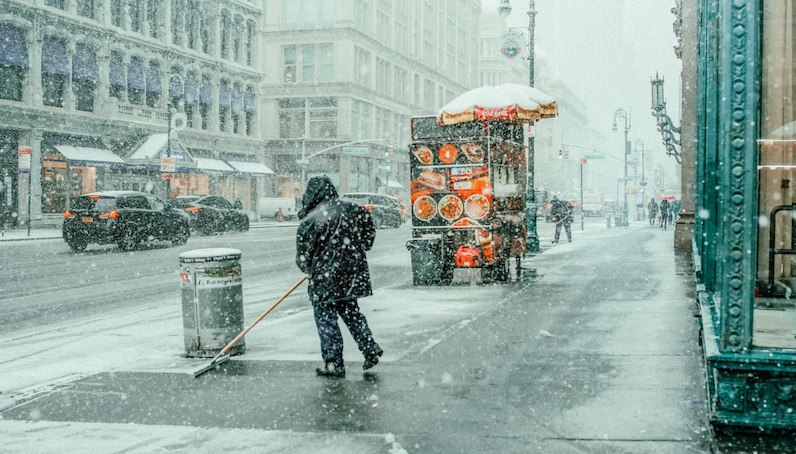How can snow, hail, ice and winter storms damage your business?
Severe winter weather can cause extensive damage to your business, both in physical impact and operational disruptions.
Here are some of the most common risks:
- Roof damage. Heavy snow and ice accumulation can lead to roof collapses, leaks or structural strain.
- Frozen pipes and water damage. Extreme cold can cause pipes to freeze and burst, leading to flooding, water damage and mold growth.
- Hail damage. Hail can crack windows, dent exteriors and damage vehicles parked outside.
- Slip-and-fall hazards. Icy sidewalks and parking lots increase liability risks if a customer or employee is injured.
- Business interruptions. Power outages, impassable roads or facility damage can force businesses to temporarily close. These kinds of business interruptions can lead to lost revenue.
8 tips to help protect your business from winter storms
Winter storms can’t be prevented, but businesses can take proactive steps to reduce their vulnerabilities.
Here are some protection tips to help safeguard your business:
1. Inspect and maintain your roof
- Remove excess snow to prevent roof collapse.
- Inspect for loose shingles, cracks or leaks before winter begins.
- Reinforce older roofs to withstand heavy snow and ice accumulation.
2. Prevent frozen and burst pipes
- Insulate exposed pipes, especially in unheated areas like basements or storage rooms.
- Keep indoor temperatures above freezing, even when your business is closed.
- Let faucets drip slightly to relieve pressure in the pipes during extreme cold.
3. Clear snow and ice around your property
- Shovel and salt sidewalks, entryways and parking lots to help reduce slip-and-fall accidents.
- Install non-slip mats at entrances to prevent wet floors indoors.
- Hire a professional snow removal service if needed.
4. Review and update your business insurance coverage
- Check that your policies include winter storm protection.
- Consider additional coverage if your current coverage isn’t sufficient for your business size, location and risk.
- Get an instant quote to assess your risks and check out coverage recommendations customized for your business.
5. Secure windows, doors and gutters
- Inspect and reinforce doors and windows to prevent leaks and drafts.
- Clear gutters before winter to avoid ice dams that could cause water damage.
- Install storm shutters or protective film on glass to reduce hail damage.
6. Prepare for power outages
- Invest in a backup generator to keep critical systems, such as refrigerators or freezers, running.
- Prepare an emergency kit with flashlights, batteries and blankets in case of extended outages.
- Use surge protectors to prevent damage to electronics from power fluctuations.
7. Protect business vehicles
- Park company vehicles inside a garage or covered area when possible.
- Use hail-resistant covers for fleet vehicles.
- Keep emergency supplies like ice scrapers, blankets and jumper cables inside company vehicles.
8. Develop a winter storm emergency plan
- Train employees on winter weather procedures and safety protocols.
- Have a business continuity and communication plan to keep staff and customers informed during closures.
- Store important business documents and data backups in a safe location.
What type of commercial insurance can help cover winter storm damage?
Business insurance can help cover some snow and winter storm damage events.
If you’re not sure what kind of coverage you need, you’re not alone: According to a NEXT survey conducted by Wakefield Research, 90% of small business owners lack confidence that they have enough insurance for their small business. The fact is that many small businesses require more than one type of business insurance.
Here are some of the policies you may need:
Commercial Property insurance
Commercial property insurance is the primary coverage for snow, ice, hail and winter storm damage. Also known as hazard business insurance, this type of coverage can help cover costs of repairing or replacing your building structure and business assets if they’re damaged.
But depending on the specifics of your risk, a standard commercial property policy may not be enough. You may need to supplement your policy with a rider or insurance endorsement — an add-on to cover things like tools, spoiled food or other inventory specific to your line of work.
General Liability insurance
General liability insurance generally doesn’t protect property damage to your own property (that’s what commercial property insurance is for). But if a customer or visitor slips and falls due to ice or snow on your property, general liability coverage could help cover medical bills and legal costs.
BOP insurance (Business Owner’s Policy)
Commercial property coverage is usually for the things you own, and general liability is usually for injuries to others or damage to other people’s property. It’s common for small business owners to want both types of coverage. And you can get both together with BOP insurance, also called a Business Owner’s Policy, and usually pay less than you would for two separate policies.
Business Income insurance
If a winter storm forces your business to close temporarily due to a covered loss, business income insurance, also known as business interruption coverage, may help replace lost revenue during that downtime.
Commercial Auto insurance
If company vehicles are damaged in a hailstorm or winter accident, commercial auto insurance may help cover repair or replacement costs.
The best way to find out the specific protection your business needs is to get an instant quote that can assess your unique risks and make coverage recommendations just for you.
Can businesses make a claim for storm damage from snow, ice and hail?
If your business experiences winter storm damage, you can file a claim. But be aware that your coverage will depend on the details of your policy and the cause of the damage.
When filing a claim, follow these steps to simplify the process and expedite claims processing:
- Document the damage. Take photos and videos of all snow, hail or ice-related damage as soon as it’s safe to do so.
- File the claim promptly. Many insurance providers have time limits for reporting storm-related damage.
- Provide maintenance records. You’ll want to offer proof that you took proactive steps to properly winterize your business before the incident occurred.
- Work with your insurance company. Your insurance provider may need to assess the damage. Be prepared to provide receipts, invoices and any relevant records as needed.
With the right small business insurance coverage for winter weather, your business can be prepared for whatever heads your way — and help to have you back in business before the snow melts.









